Alloy Steel is a combination of carbon steels and several other alloying elements such as chromium, aluminium, titanium and nickel. The alloying element which is included is around 5% of its composition. There are 57 types of alloy steel on the market today with the majority of Alloy being made by mixing metals into a mould and forming them at 3,000 degrees Fahrenheit for around 8 to 12 hours. Once bonding has taken place between the base elements this can then be cooled in the air for four hours.

Alloy Steel is commonly used for the building of large structures such as bridges, stadiums and bridges due to its strength and resistance to corrosion, it poses a tougher than normal steel that will last for years to follow. Bridges, for example, are extremely fast to produce whilst being part of modern-day infrastructure suitable to carry road traffic that can flex without fracturing and survive even the harshest conditions.
Another large sector where Alloy Steel is widely used is within the production of pipework.
P1 S eamless Alloy Steel pipes are produced for the use of the Oil and Gas pipeline transport system. There are currently more than 2,175,000 miles of pipelines around the world transporting liquids and gases to the required market area for consumption.
eamless Alloy Steel pipes are produced for the use of the Oil and Gas pipeline transport system. There are currently more than 2,175,000 miles of pipelines around the world transporting liquids and gases to the required market area for consumption.
P9 Alloy Steel Pipes are used within the plumbing sector, these seamless pipes are excellent at handling high temperature and distributing water without corrosion. Lastly, ASTM A213 Alloy Steel pipework is generally used around the home for heating elements. This type of Alloy Steel meets the requirements needed for hot forming. The heat exchanger tubes can resist high temperatures whilst distributing an even heat element into the home.
One benefit of using Alloy Steel and a major factor to why it is the preferred method of steel today is that it can be recycled. Alloy Steel is 100% recyclable and can be recycled over and over again without losing any of its properties, making it an ideal environmental performer whilst keeping its strength and durability. Predictions are that Alloy Steel will remain in use for many decades.
